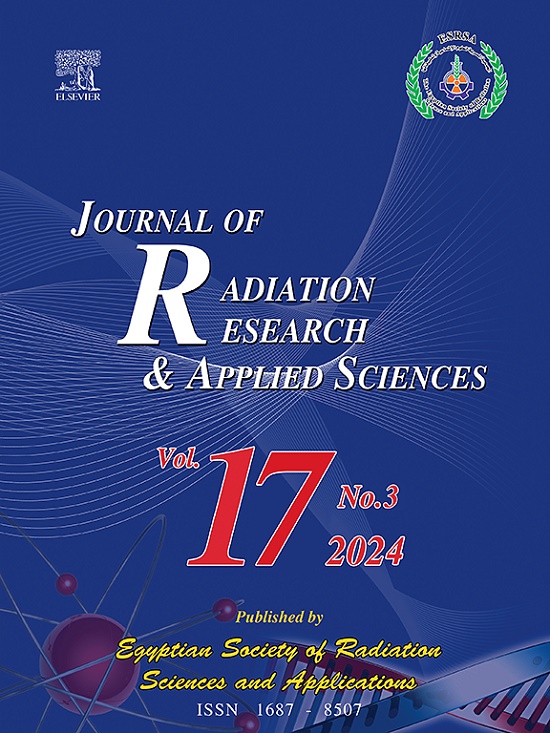Assessment of radon concentrations and associated health risks via surface and groundwater consumption in the Utmah, Yemen
IF 1.7
4区 综合性期刊
Q2 MULTIDISCIPLINARY SCIENCES
Journal of Radiation Research and Applied Sciences
Pub Date : 2025-05-20
DOI:10.1016/j.jrras.2025.101639
引用次数: 0
Abstract
Radon, a naturally occurring radioactive gas, poses health risks through water consumption. In seismically active regions like Utmah, Yemen, geological factors may elevate radon levels in water, requiring monitoring. This study analyzed radon concentrations in groundwater and surface water used for drinking, domestic purposes, and irrigation in Utmah Nature Reserve, Dhamar Governorate, Yemen. Thirty-four water samples were collected: 14 surface water samples (depth <15 m) and 20 groundwater samples (depth 110–320 m) from Al-Azraa and Tahayjer. Radon and radium were measured using CR-39 nuclear track detectors. Results showed surface water radon levels ranged from 0.09 ± 0.03 to 0.25 ± 0.03 Bq/L (average 0.17 ± 0.04 Bq/L), while groundwater levels were higher: 0.20 ± 0.03 to 0.52 ± 0.09 Bq/L (average 0.34 ± 0.06 Bq/L), well below the international safety standard of 11.1 Bq/L set by the U.S. Environmental Protection Agency (EPA). Annual radiation exposure from surface water (inhalation/ingestion) ranged from 0.23 ± 0.08 to 0.64 ± 0.08 μSv/year (average 0.43 μSv/year). Groundwater exposure was higher: 0.50 ± 0.08 to 1.33 ± 0.23 μSv/year (average 0.86–0.87 μSv/year), still below the World Health Organization (WHO) limit (100 μSv/year). The analysis revealed that depth plays a role in radon distribution, with variations observed between surface and groundwater samples. This is likely influenced by geological characteristics or seismic activity in the area. The findings suggest that water sources in the studied locations do not pose significant radiological health risks due to radon exposure. This research highlights the urgent need for ongoing radon monitoring, especially in seismically active regions. The study provides valuable insights into the potential health impacts of radon in drinking water, contributing to improved international health and safety practices.
通过也门乌特玛地表水和地下水消耗评估氡浓度和相关健康风险
氡是一种天然存在的放射性气体,通过饮水对健康构成威胁。在像也门乌特玛这样的地震活跃地区,地质因素可能会提高水中的氡水平,需要监测。本研究分析了也门达马省乌特玛自然保护区用于饮用、生活和灌溉的地下水和地表水中的氡浓度。收集了34个水样:14个地表水样品(深度<;15 m)和20个地下水样品(深度110-320 m)来自Al-Azraa和Tahayjer。用CR-39型核径迹探测器测量氡和镭。结果显示,地表水氡水平为0.09±0.03 ~ 0.25±0.03 Bq/L(平均0.17±0.04 Bq/L),地下水氡水平较高,为0.20±0.03 ~ 0.52±0.09 Bq/L(平均0.34±0.06 Bq/L),远低于美国环境保护署(EPA)规定的11.1 Bq/L的国际安全标准。年地表水(吸入/摄入)辐射暴露量范围为0.23±0.08 ~ 0.64±0.08 μSv/年(平均0.43 μSv/年)。地下水暴露量较高,为0.50±0.08 ~ 1.33±0.23 μSv/年(平均0.86 ~ 0.87 μSv/年),仍低于世界卫生组织(WHO)规定的限值(100 μSv/年)。分析表明,深度在氡分布中起作用,地表和地下水样本之间存在差异。这可能受到该地区地质特征或地震活动的影响。研究结果表明,所研究地点的水源不会因氡暴露而造成重大的放射性健康风险。这项研究突出了持续监测氡的迫切需要,特别是在地震活跃地区。这项研究为饮用水中氡对健康的潜在影响提供了宝贵的见解,有助于改进国际卫生和安全做法。
本文章由计算机程序翻译,如有差异,请以英文原文为准。
求助全文
约1分钟内获得全文
求助全文
来源期刊

Journal of Radiation Research and Applied Sciences
MULTIDISCIPLINARY SCIENCES-
自引率
5.90%
发文量
130
审稿时长
16 weeks
期刊介绍:
Journal of Radiation Research and Applied Sciences provides a high quality medium for the publication of substantial, original and scientific and technological papers on the development and applications of nuclear, radiation and isotopes in biology, medicine, drugs, biochemistry, microbiology, agriculture, entomology, food technology, chemistry, physics, solid states, engineering, environmental and applied sciences.
 求助内容:
求助内容: 应助结果提醒方式:
应助结果提醒方式:


